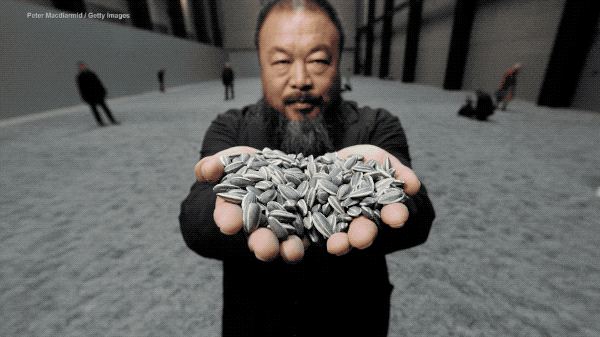What's an art installation and why do they make people mad?
Professor Lise (not really a professor) explains sculpture's complicated cousin

Hey guys!
Have you ever taken your uncle to an art gallery and you're in a room where there's like 1,700 daisies on the floor, there's a toy piano in the middle of the room and a huge model of the moon hanging over the whole thing and your uncle is like "WHAT IS THIS? I'M SO MAD" and he goes to the gallery cafe to eat a resentful bowl of soup and think about the good old days.
Watch the video:
I'm Professor Lise. I have 193 PhDs, 24 Masters and almost 1 BA. And for this edition of Art 101 we're talking about installation — that form of art that seems like it should be sculpture but has way more parts and makes your uncle mad.
A sculpture is fairly easy to define. Encyclopedia Britannica calls it an artistic form in which hard or plastic materials are worked into three-dimensional art objects. So, sculpture's a three-dimensional thing. Maybe it's a portrait bust or a unicorn or just a plain-looking box. But, it's an object. It's tangible and it's in one piece. You can pick it up if it's not too heavy or you can take it away in a truck or you can just point at it and say, "Hey, that's a sculpture."

The word installation is a bit different — call it sculpture's complicated cousin. An installation might take up a whole room. It might have some video, a bunch of sculptures, maybe even some wind or some sound. An installation is made of many elements that have a relationship to each other to make a larger point or build a larger story. And rather than the specific objects being independently important, it's the relationship between all of them that creates meaning. Let's look at some examples!

Remember that Yayoi Kusama exhibition where you lined up for 18 hours so your uncle could get a selfie in one of her infinity rooms? In those rooms there were a multitude of elements that made the room amazing — pumpkins, mirrors, twinkling lights. Each object or sculpture itself was just a thing, but the atmosphere they created together was magical and made a tiny closet feel like an immense landscape.

Ai Weiwei is a Chinese political artist protesting the regime in which he grew up. He's a highly rebellious artist and installation art has been his most powerful medium. Take Sunflower Seeds, where he used a hundred million porcelain replicas of sunflower seeds made by 1600 people to comment on his feelings about mass production. The sheer scale of this installation — tiny seeds filling up a massive space — made a huge political statement.

Some artists go even bigger in installation art. Christo and his partner Jeanne-Claude made their reputation by covering huge landmarks with draped pieces of cloth. They also called their work environmental art. They wrapped the Reichstag in Berlin, and after Jeanne-Claude passed away, Christo kept going, creating a three kilometer-long runway floating on water in Italy that people could walk on.

Again, you can't walk away with these installations, you kind of can't buy them, but they create an immersive experience that's quite different from what a sculpture can do.

Installations can cover big ideas. In 1979, American artist Judy Chicago created a piece called The Dinner Party that made a major case for feminism. It was a huge triangular table, and each place setting — from plates to cups to cutlery — was made in honour of an important woman, like Emily Dickinson or Virginia Woolfe. All together, the table created a vision of a pretty badass feast and made the point that there have been a ton of powerful women through history even if history's chosen to ignore them.
An installation can also just simply be emotionally overwhelming. This form is really effective at making you feel a sensation, be it physical, emotional or intellectual.

In 2008, artist Olafur Eliasson created an installation at London's Tate Modern and called it The Weather Project. It was dominated by a huge blazing artificial sun, and just using light and shadow, he created an immersive experience filled with hope and wonder and the moment before sunset that never ends.
So, why are installations important? Why not just stick to sculpture? If we break it down to its simplest, installations let artists do things that sculpture can't. Artists use installation to involve us more with the art. We get to stand in a space and have a different experience than looking at a single object — which in turn, might make us think a little more or feel a little more.
Installations let artists comment on the world in a complex way and make us part of the experience. They're also tricky to sell so kudos to the artists for taking a risk.

In conclusion, installations are really good at making uncles angry and forcing them to eat soup.
But I hope you can use this little primer to convince your uncle to give the installation another go and keep your relationship going until your next gallery visit.
I'll see you both here next time for more Art 101.


